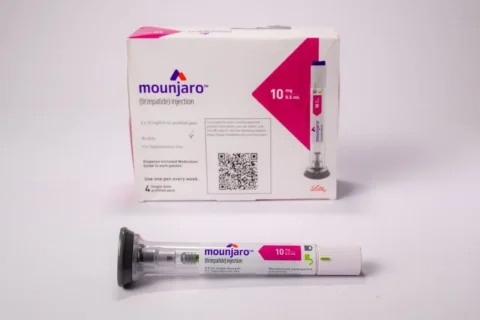If you have excess unhealthy weight and your doctor has told you your cholesterol (lipid panel) numbers are a cause for concern, you’ve got two great reasons to make healthy lifestyle changes—starting today.
Along with blood sugar levels and blood pressure, both unhealthy weight (excess fat) and unhealthy cholesterol numbers are strongly linked to cardiovascular disease (heart and blood vessel problems), which can lead to heart attack, stroke, and other serious health problems.
In this article, we’ll focus on the cardiovascular risk factors of high cholesterol and excess weight (particularly excess inches of fat in the waist and abdominal area) to understand how they relate to each other and why it’s important to “know your numbers.”
Why are cholesterol panel numbers so important?
A cholesterol panel (also called a lipid panel, lipid profile, or lipid screening) includes lab measurements of your total cholesterol, LDL cholesterol (“bad cholesterol”), HDL cholesterol (“good cholesterol”), and other types of circulating molecules that can give your doctor a better idea of your risk for developing cardiovascular disease (disease of the heart and blood vessels).
Keeping all of your cholesterol numbers within healthy ranges is one way to lower your risk of health issues related to cardiovascular disease, including heart attack and stroke.
Cardiovascular disease is a big deal.
In American adults, 1 in 3 deaths are caused by cardiovascular disease.
Do I need a lipid screening (aka cholesterol panel)?
In adults at least 20 years old who are not on lipid-lowering therapy (that is, cholesterol meds such as statins), a fasting or nonfasting lipid panel can help your doctor estimate your risk for cardiovascular disease. After this initial screening test, your doctor will then proceed to order more screening tests as you age to determine your risk for developing cardiovascular disease, and the best strategies you can use to lower your risk.
When and how often you should get a blood draw for a lipid profile is unique to you and should be decided between you and your doctor. If you have other risk factors for heart disease, including if you smoke or if you have diabetes, obesity, high blood pressure, or family history of heart disease at a young age, your screenings should start earlier in life than if you have none of these risk factors.
What are the current guidelines for “healthy cholesterol levels”?
While there is some debate over which cholesterol numbers from a lipid panel are most important, most medical providers rely on the American Heart Association’s guidelines for acceptable or normal cholesterol numbers.
| Normal Lipid Panel Levels (measurements in mg/dL) | |
| Total Cholesterol | 125-200 |
| LDL Cholesterol | 100 (or less—lower is better) |
| HDL Cholesterol | At least 40 (males) or 50 (females) |
| Triglycerides | Less than 150 (fasting blood test) |
Of the tests in the lipid panel, total cholesterol gives the least amount of info—it’s more important to know what kinds of cholesterol are out of proportion in your body. So, decisions about when to treat unhealthy lipid panel numbers are usually based upon the level of LDL (“bad”) or HDL (“good”) cholesterol rather than the level of total cholesterol. Both high levels of LDL cholesterol and/or low levels of HDL cholesterol are associated with an increased risk of atherosclerotic cardiovascular disease (ASCVD), which is a build-up of plaque in the arteries.
What are the current guidelines for “healthy weight”?
Most medical providers use the national guidelines on BMI as a place to start when gauging how healthy someone’s weight is:
| Weight category by Body Mass Index (BMI) | |
| BMI below 18.5 | Underweight |
| BMI 18.5 to 24.9 | Healthy Weight |
| BMI 25 to 29.9 | Overweight |
| BMI 30 or above | Obese |
Remember that BMI is only a basic measurement—it is based on total body weight and not fat. The American Medical Association (AMA) suggests that BMI be used along with other valid measurements, such as visceral fat, body adiposity index, body composition, relative fat mass, waist circumference, and genetic/metabolic factors. This is an important point because not all obesity is equal.
Central obesity (excess fat in the waist and abdomen), for instance, is more unhealthy than excess fat deposits in other locations, such as thighs and buttocks. Someone can have obesity or overweight (according to their BMI) but have a healthy metabolism (that is, their insulin is working properly), and some people can have a normal BMI but have metabolic issues (that is, their insulin levels are high because their insulin is not working as it should).
If your BMI is high, it’s important to consider more specific tests that measure the fat in your body and where it is located. This information can help your provider determine if you are metabolically healthy or unhealthy.
What causes cholesterol numbers to be high or low?
Finding the true cause behind high cholesterol levels (and, in turn, a higher risk for developing cardiovascular disease) is a complex task, and scientists are still working on specific answers.
But here’s what we do know:
1. Genetics and family history contribute to cholesterol numbers.
- Familial combined hyperlipidemia, which involves having high cholesterol and triglyceride levels, is associated with increased risk of getting cardiovascular disease early in life
- A family history of heart disease is a risk factor for developing heart disease yourself
- If you’ve got a high HDL (which is a good thing), this could be due to genes you inherited.
2. Not all dietary fat is created equal. All fat we eat falls into 1 of 3 categories: trans fat, saturated fat, or unsaturated fat:
- Trans fats (trans fatty acids) are fats that are chemically changed via processing called hydrogenation to create “partially hydrogenated oils,” which are bad for your health. Fortunately, trans fats now make up a very small percentage of the American diet thanks to government bans and increased knowledge of how harmful trans fats are.
- Despite being labeled a “bad fat,” saturated fat gets mixed opinions from experts on how much we should eat. The Dietary Guidelines for Americans recommends limiting saturated fat to 10% of daily calories, and the American Heart Association suggests going even lower, aiming for just 5% to 6% of calories from saturated fat. As more research is conducted, though, this guidance may change as several studies have found that high-saturated fat diets don’t raise the risk of heart disease.
- Regardless of these studies, it’s still an accepted truth that unsaturated fats are better for you than saturated fats. Unsaturated fats may even increase your good cholesterol (HDL) levels. And it’s also safe to say that if you do decide to eat less saturated fat, you should be careful not to replace the saturated fat with sugars and/or carbohydrates.
Should I eat less cholesterol?
While it may seem odd, increased dietary cholesterol does not significantly raise cholesterol levels in the blood or increase the risk of cardiovascular disease (though it is still recommended to not go overboard on high-cholesterol foods). Contrary to popular belief, for instance, eating eggs will not raise your blood cholesterol levels.
3. Sugar and highly processed foods contribute to high cholesterol.
- Americans tend to eat and drink a lot of sugar, carbohydrates, and processed foods. Sugary drinks and baked goods are two big culprits. This excess intake of foods that are low in nutritional value can add on pounds of unhealthy weight and can eventually throw your lipid metabolism off track.
- High carbohydrate foods turn into sugar in your stomach and intestines, and can be just as unhealthy as eating sugar. Examples of high carbohydrate foods include bread, pasta, rice, and cereals.
4. Unhealthy habits and existing conditions add health risks. Although LDL cholesterol is often blamed for clogging arteries and causing cardiovascular disease, other risk factors for cardiovascular disease contribute as well, including:
- Cigarette smoking
- Diabetes
- High blood pressure
- Chronic kidney disease
- Inactive lifestyle
- Obesity
How are cholesterol and weight (body fat) related?
From decades of research, we know that obesity is linked to cardiovascular problems such as heart disease. We also know that cholesterol lab results (such as LDL, HDL, and triglycerides) are linked to cardiovascular disease. But how does it all tie in together?
Scientists and researchers are still piecing together exactly how everything works together to affect our body composition and metabolism, but they’re asking the right questions. Here’s what we do know about the connection between body weight, cholesterol, and other health factors.
Obesity is a risk factor
Obesity and overweight have been linked to many health conditions:
- America has high rates of obesity and cardiovascular disease, and obesity has been linked to a higher risk of cardiovascular disease
- Obesity is estimated to account for 7 out of 10 high blood pressure cases
- Excess body fat and obesity are significant risk factors for type 2 diabetes.
- Excess unhealthy weight—and particularly abdominal obesity—is closely linked to metabolic syndrome (read on to learn more about metabolic syndrome).
Not all excess body fat is created equal
If you have obesity or overweight, it’s important to know not just your weight and BMI but also what kind of fat your body is storing, because this has an effect on your risk factors for certain diseases or conditions. Information about how your body processes food, stores fat, and releases energy can give insights into whether or not your metabolism is working correctly.
Metabolic syndrome ties together cholesterol, weight, and more
Metabolic syndrome is a risk-enhancing factor for cardiovascular disease and commonly occurs in patients with type 2 diabetes or prediabetes (high fasting glucose). Metabolic syndrome means having any 3 of the following 5 risk factors:
- Excess fat around the belly area (measured as inches around your waist)
- Triglycerides in the blood are high (greater than 150 mg/dL)
- HDL in the blood is low (less than 40 in males, less than 50 in females)
- Blood pressure is high (greater than 135/85)
- Blood sugar (glucose) is high (fasting glucose greater than 100)
As you can see from this list, 2 of the 5 factors (triglycerides and HDL) can be found on your lipid panel lab results.
About 1 in 3 adults in the United States has metabolic syndrome. The central factor of metabolic syndrome is insulin resistance—in fact, metabolic syndrome is also called insulin resistance syndrome.
Metabolic syndrome is complex. It has several causes, and each affects the other so much so that it’s difficult to identify where the problem started in the first place. For example, if you have both an increased waistline and an increased blood glucose level, it’s not clear if insulin resistance caused your body fat to increase or if increased body fat caused your insulin resistance.
3 key takeaways about cholesterol and weight
Cholesterol numbers, unhealthy weight, and many other health factors are related in complex ways that aren’t yet fully understood. Based on the past few decades of research and analysis, here are some valuable takeaways about better understanding cholesterol numbers and unhealthy weight:
- It’s important to not just know your individual cholesterol numbers but understand how they relate to each other—and it’s important to discuss all of this with your provider. This way, you can fully understand what your numbers are telling you about your health.
- LDL gets a lot of attention and is often considered the most important measurement on a cholesterol panel—but triglyceride level, HDL level, and non-HDL cholesterol are very important numbers, too.
- Cholesterol numbers and body fat are affected by many factors—and one factor that is often overlooked is the negative effects of eating too many highly processed foods and foods that are high in sugar.




